Fuchsia diseases and pests
Fuchsia – a wonderful and beautiful potted flower. But, like most other plants, it is susceptible to various pests and disease. Treatment in this case depends primarily on the degree of infestation. The sooner a problem was identified, the easier it will be to cope with it.
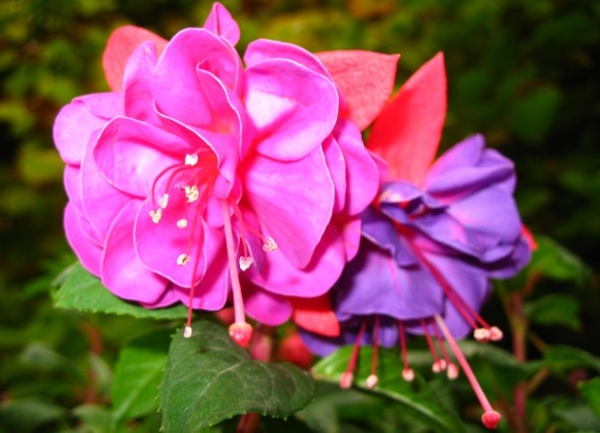
Fuchsia
Where there are pests, and plant diseases
Various misfortunes befall the plant as a result of improper care. Flower giving enough attention, you can not worry about diseases. When failed to detect the problem at an early stage, in time to exclude the hearth – flower is restored independently, without any tools.
If the trouble with the fuchsia still happened, should define clearly the problem, then the treatment will be effective.
Diseases fuchsias are divided into 2 categories:
- Disease as a consequence of improper care.
- Of moulds and pests.
The most common problem based on both factors. With proper care, even difficult pests to attack a strong plant.
First, consider the diseases associated with the root system and leaves. Signs in such cases are seen almost immediately. Important time to define them, to avoid death of the flower.
Fuchsia has white, strong roots. When they become soft, change color to brown is a sign of root rot. Basically the reason is the large amount of moisture. There is not able to help even good drainage.
Methods of combating root rot:
- The plant removed from the pot.
- And the roots are carefully washed in warm water.
- The affected roots are cut with a sharp object.
- The rest of the flower put in a container with clean water.
- With the appearance of healthy white roots, fuchsia can be planted in the new soil.
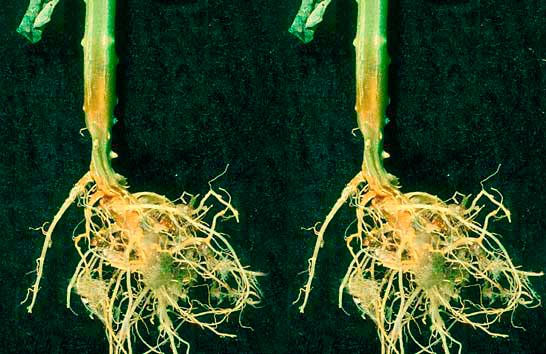
Signs of root rot
Threat to fuchsia gray mold. Part of the plant that is affected, it becomes soft and watery. This happens in the case of too moist of air in the room. On pieces of paper to form plaque. Gray mold occurs mainly in autumn or spring. It was during this period outside the window, damp wet weather.
All affected leaves should be removed, they can be cut off. The room should be dry, require periodic airing. If necessary, use the purchase money.
It happens that even with strong and healthy roots, the plant has slowed growth, the root system is highly developed and entangled in a tangle. The phenomenon has a simple explanation – not enough room. Fuchsia transplanted, and growth resumes.
Very often possible to detect a disease as the leaves. In different situations, they change color and structure:
- Brown and drying in the soil is not enough molybdenum.
- Streaks of yellow in it – in not enough soil manganese.
- The leaves turn white and wither – not enough nitrogen.
Treatment in such cases is quite simple, the plant needs to provide such a feeding, which it lacks.
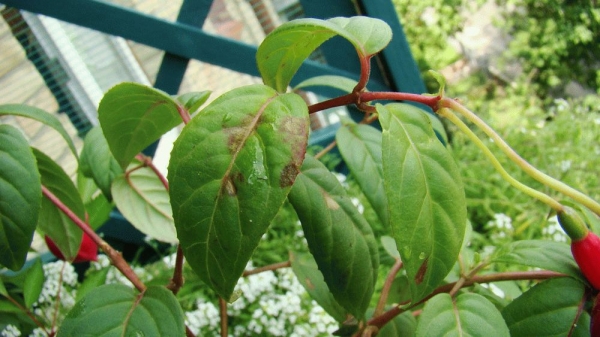
Typical disease of leaves
Another big nuisance is a pest, they are not so little. They attack mainly during the warm period of time.
On hot summer days, the Windows are often open, which allows the whitefly to fly freely in the room. To see this butterfly is quite complicated, it is very tiny. Whiteflies lay on the inner side of the sheet invisible eggs. The flower on this change responds very quickly. So the leaves form a whitish sticky droplets. The washing water in this case will not help, they will grow. Hatching from eggs, the butterfly (a lot of them) feed on plant SAP. This leaves quickly turn yellow and drop. Everything happens quickly, and if not to notice, whiteflies will eat the flower stalk.
The first thing to do in the whitefly – rinse the flower in warm soapy water. More attention should wash the inner part of the leaves and stem. Soap solution should not fall on the roots, it is detrimental. Protect them with polythene or a simple plastic bag. Fuchsia diseases and pests
In non-running situation quite a few soap treatments to get rid of the problem. When they do not help, use special purchase drugs as treatment. What's the best, tell the sellers in a flower shop.
If the air in the room in addition to warm, still and dry is a great habitat for red spider mite. Signs of damage to the fuchsia mite:
- The inner part of the foliage becomes gray patina.
- Appears thin gossamer.
- The leaves develop black spots.
Get rid of the tick is simple traditional methods can be extremely rare. It is better not to rely on luck, and buy a special product.
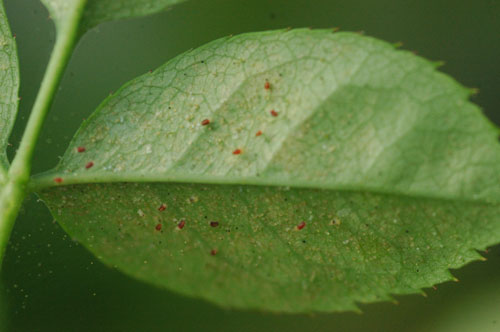
Spider mites
Note! All purchase funds are used in accordance with the instructions or recommendations of the growers. To use them for other purposes is also harmful.
When you find pests on fuchsia, it should be isolated from other houseplants. To exclude contamination, in summer, the flower treated with special means. Prevention in this case is a must.
Another common disease is rust. Is expressed on the leaves brown spots. The disease spreads rapidly and requires immediate treatment:
- All the affected leaves immediately removed, they are cut with a sharp object.
- Preparing a soap solution (soap) is processed the whole plant.
- Be sure to use special tools.
Rust is very contagious, all tools should be disinfected after removing the "sick" leaves, hands are washed and disinfected. Only after that you can continue working with flower.
Unpleasant disease of fuchsia – foliar nematodes. Bruise the leaves of the flower, between the veins and cause yellow spots, which eventually become brown. The foliage begins to crumble. If the plant to be sprayed frequently, nematodes are rapidly for it to multiply. Fuchsia diseases and pests
Fighting this disease begins with the removal of the affected leaves. It should significantly reduce the water, from spraying to take time off.
Important! To propagate a plant that is sick, in any case impossible.
Caterpillar pests, which will be quickly detected. They eat leaves, can also be seen leaving a trail of tracks in the form of black dots (their feces).
When mass destruction and used as treatment of insecticides. In addition, the fuchsia regularly inspect and clean the tracks. It is better to search in the evening.
A fairly common pest, the aphid. It has the ability to hit the entire plant, and not its individual parts. Aphids on houseplants can have razlikuju color palette: green, red, black. Can hit:
- Root system.
- Stems.
- Buds.
- Leaves.
Flowers, buds and leaves begin to curl, turn yellow and fall off. Aphids on the affected parts of the plant visible adhesive selection. If time does not recognize such pest as aphids, rose will quickly die.
When aphids found on one plant, to deal with it redeems the flower in soapy water. If aphids struck by fuchsia hard enough or went a collective infection without professional drugs can not do, buy them in a flower shop.
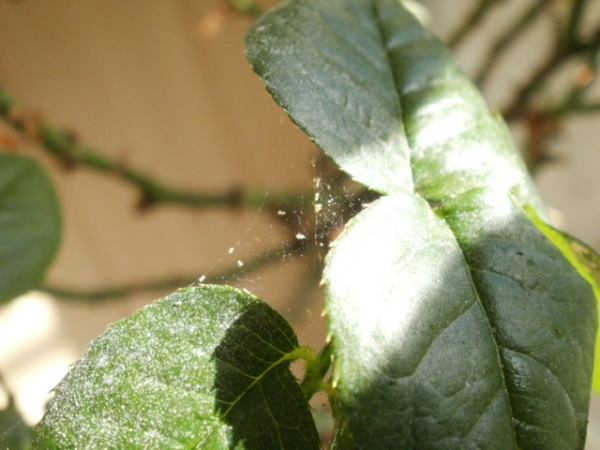
aphids on fuchsia
Aphids may appear on the flower thus:
- To fly into the open window.
- May be in the soil in which the flower is planted, especially if it was taken in the store and in the garden.
- Gets new plants. May have been donated or bought a flower that was already infected. Of course, aphids will spread.
Strong and healthy plant, which is attentive care is much less likely to attack aphids and other pests.
Caring correctly
Again, the fact that diseases and pests appear in fuchsia force improper care.
Fuchsia has a large number of species. Its flowers have a different color palette. So on the windowsill you can collect all the colors of the rainbow.
Care rules:
- Watering. In the warm season flower needs frequent and abundant watering. Once you see the drying the top layer of soil, to safely handle the watering. In cold weather, watering is greatly reduced. In the last 2 months of autumn watering can does stop. When the room temperature is quite low, watering is carried out a couple of times a month.
Water is used at a distance, a crane can not be watered.
- Light. All kinds of fuchsias like bright lighting. It should be diffused. The scorching sun can really take their toll on the flower. During flowering fuchsia do not twist and do not move, otherwise the color will crumble.
- Temperature. During the growing season optimum temperature of 18-25 degrees. In summer, the flower can be planted in the open ground. Temperatures over 30 degrees is fraught with consequences:
- Fall leaves.
- Stops flowering.
- The flower dries up.
On hot days the sun rose out of the window sills, it is desirable to make it on a balcony or loggia. Direct sunlight will destroy the flower.
Heat is not good for the root system, so it is recommended to use for planting pots made of ceramic, they are not exposed to extreme heat.
- Fertilize and feed. Fuchsia during the growth needs regular spraying of the leaves. Do it better in the morning and evening. To humidify the air around with a flower pot and put a container of pebbles (pebbles) filled with water. In cold weather the moisture will cause harm, the spraying stopped.
As dressing you can use any of the purchase funds, which are designed for houseplants.
In winter, fertilizer is not necessary, begin to add at the end of March. Frequency – every 7 days, before the cold weather. Fuchsia diseases and pests
- Transplant. This point is very important because if you use poor soil may develop various diseases, appear pests (e.g., aphids).
Transplant the flower should be given annually in the spring. The soil acquire in a flower shop. Certainly on the bottom of the pot to put drainage, so there was no excess moisture. A pot choose a large size.
- Reproduction. Also a very important factor, during this period, the flower needs special care, as it is during reproduction is considered the most vulnerable and weak.
To propagate fuchsia can 3 ways:
- Cuttings.
- Seeds.
- Leaves.
Propagated by cuttings. Start the process with the end of winter, beginning of March. Those varieties that grow slowly, reproduce at the end of August, beginning of September. Cuttings taken with a length of 5-7 inches. Rooting is well in the loose environment. It can be as sand and water. In less than a month (20-25 days) as I see the first roots. At this point the cuttings can be put in pots with a depth of 7-9 inches. The soil can be prepared independently, it must contain:
- Humus.
- Sand.
- Leaf or grassy land.
All the ingredients are mixed in equal amounts.
To the splendor of a flower in one pot planted several cuttings. Their flowering can be expected in the same year.
Propagated by seeds. To plant seeds require artificial pollination. This is a very interesting process. You can mix several types of fuchsias. The result will be new varieties, the color palette will expand your horizons.
Propagated by leaves. This type of breeding should be conducted on a clear pattern:
- Choose a strong stem. It should be a strong and developed leaves.
- The obtained material is placed in loose soil to a depth of not more than 1 centimeter.
- Planted leaves cover (you can use lids from plastic or glass).
- Perform daily spraying.
- Tap water can not be taken, it should be boiled and warm. Be careful not to burn the plant!
- The appearance of the first small rostochek demonstrates the need for transplants in pots.
Reproducing fuchsia is possible to obtain different and excellent varieties and types. Better to do it yourself, then you beduet confident that the plant will grow strong and healthy. Borne seeds, sprouts, leaves with "the street" can have different problems which will have to fight. In the worst case, they infect other plants. Fuchsia diseases and pests
Possible problems
Problems that might be faced by the grower:
- The rose does not bloom. The reasons for this are:
- In winter, the flower was warm.
- Excessive watering.
- In the warm season was a rare watering or not enough feeding.
- During the growing season there is little light.
- The leaves of the flower wither, dry and fall off. The reasons for this are:
- And the air is too dry, the soil lacks moisture.
- The flowers of fuchsia are not disclosed. The reasons for this are:
- An excessive amount of moisture.
Very often, any problems with the flower do not signal about diseases and pests, and to show improper care. In this case, it is not necessary to resort to different funds, enough to pay of fuchsia due attention.
How to plant dill seeds and seedlings in the open ground, planting dates
